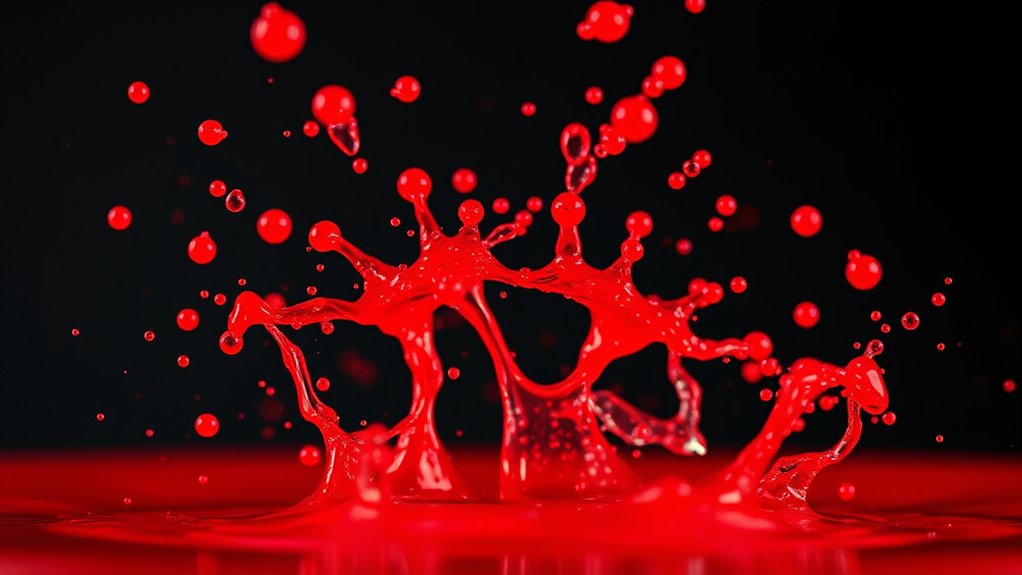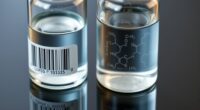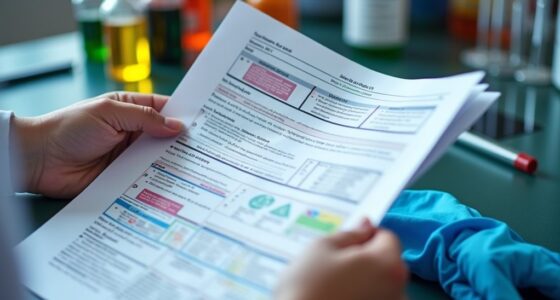Understanding the chemistry of allergies involves knowing how histamine signals your immune system during reactions, causing symptoms like itching or sneezing. Antihistamines work by blocking histamine’s interaction with H1 receptors, preventing these symptoms. Different receptor types regulate various functions, such as stomach acid or nerve activity. The production and breakdown of histamine rely on specific enzymes, maintaining balance. Exploring further reveals how new therapies target these receptor pathways to improve allergy relief.
Key Takeaways
- Histamine is produced by immune cells during allergic reactions, causing symptoms like itching and swelling through interaction with H1 receptors.
- Antihistamines block histamine at H1 receptors, preventing allergic symptoms by competitive antagonism.
- Histamine is synthesized from L-histidine and broken down by enzymes HMT and DAO to regulate immune responses.
- Different antihistamines vary in sedative effects; first-generation can cause drowsiness, while second-generation are less sedating.
- Emerging therapies target specific histamine receptors, especially H4, for improved allergy management and personalized treatment options.
The Role of Histamine in Immune Responses
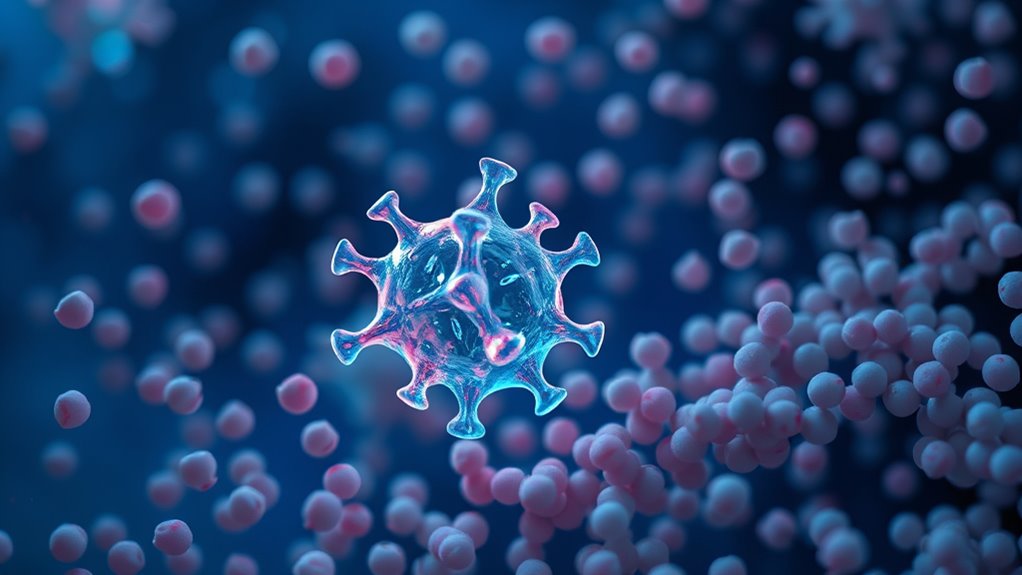
Have you ever wondered how your body reacts during an allergic response? When you encounter an allergen, your immune cells, like mast cells and basophils, produce histamine. This chemical release triggers your body’s inflammatory response, leading to common allergy symptoms like itching, sneezing, and swelling.
Histamine acts as a key mediator, signaling immune cells to respond and protect against foreign invaders. It also interacts with various immune cells, such as T lymphocytes and macrophages, to help regulate immune functions. Ongoing monitoring of AI behavior is essential to ensure safety and mitigate vulnerabilities related to immune system modeling. The exaggerated release of histamine during allergies is an example of how immune responses can become dysregulated when self-regulation mechanisms are overwhelmed or impaired. Additionally, understanding how histamine influences water-related processes can provide insights into allergy symptoms like nasal congestion and fluid buildup.
These interactions amplify inflammation and recruit more immune cells to the affected area. Essentially, histamine’s role is to alert and mobilize your immune system, but during allergies, this response becomes exaggerated, causing the uncomfortable symptoms you experience.
How Antihistamines Alleviate Allergic Symptoms
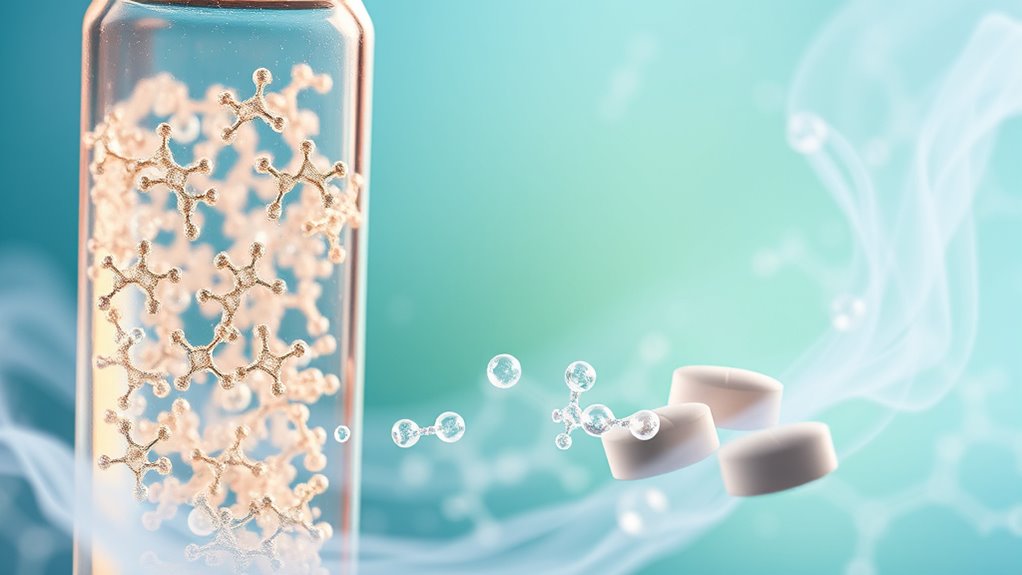
Antihistamines alleviate allergic symptoms by blocking the action of histamine at H1-receptors, which are involved in the inflammatory response. By binding to these receptors, antihistamines prevent histamine from triggering symptoms like itching, sneezing, and a runny nose.
They act through competitive antagonism, directly competing with histamine at the receptor site. This reduces inflammation and other allergic reactions on target cells such as mast cells, smooth muscle, and the endothelium.
Different generations of antihistamines offer varying side effects; first-generation types can cause sedation, while second-generation options are less sedating and suitable for daytime use.
Different Types of Histamine Receptors and Their Functions

Histamine exerts its effects through four distinct receptor subtypes—H1, H2, H3, and H4—each with unique roles in the body. H1 receptors are key players in allergic reactions, causing itching, swelling, and redness by promoting inflammation, vasodilation, and bronchoconstriction. You’ll find them in smooth muscles, blood vessels, and the nervous system.
H2 receptors primarily control gastric acid secretion in the stomach and influence blood vessel permeability, affecting digestion and inflammation. The distribution of H2 receptors in the gastrointestinal tract is a major reason why H2 antagonists are effective in treating ulcers and acid reflux. Their specific roles demonstrate how different histamine receptors are involved in varied physiological processes.
H3 receptors mainly modulate neurotransmitter release in the brain, impacting sleep, cognition, and appetite. They are also involved in the regulation of other neurochemical processes which makes them a target for certain neurological treatments.
H4 receptors are involved in immune responses, regulating the movement and activation of immune cells like mast cells, eosinophils, and T cells. Understanding the distribution of these receptors helps in developing targeted pharmacological treatments for various allergic and inflammatory conditions.
This diversity allows histamine to influence multiple physiological processes across different tissues.
The Chemical Pathways of Histamine Production and Breakdown

Histamine production begins with the enzyme L-histidine decarboxylase, which converts the amino acid L-histidine into histamine using pyridoxal-5′-phosphate as a cofactor.
You’ll find histamine mainly in mast cells, basophils, histaminergic neurons, and stomach ECL cells.
When stimulated by gastrin or acetylcholine, ECL cells release histamine stored in granules linked to heparin, increasing vascular permeability during immune responses.
To break down histamine, your body relies on enzymes like histamine-N-methyltransferase (HMT) and diamine oxidase (DAO).
HMT methylates histamine, while DAO oxidizes it into imidazolacetaldehyde, which is further converted to imidazole-4-acetic acid.
Factors like inhibitors (tacrine, metoprine) and tissue-specific regulation ensure histamine levels stay balanced, preventing overreaction and maintaining proper physiological functions.
Emerging Research and Therapeutic Strategies Targeting Histamine Receptors

Recent advances in understanding the diverse roles of histamine receptors have opened new avenues for targeted allergy treatments. You now have options beyond traditional antihistamines, with research focusing on specific receptor types like H4R, which modulates immune cell function. Targeting H4R could lead to more effective therapies for allergic diseases.
Combination strategies, such as pairing antihistamines with corticosteroids or biologics, show promise for severe cases. Future approaches aim to personalize treatments based on genetic profiles and disease severity, enhancing efficacy and reducing side effects.
Researchers are also exploring prophylactic uses of receptor-targeted drugs to prevent allergy symptoms before they start. These innovations could revolutionize allergy management by offering more precise, effective, and tailored therapies.
Frequently Asked Questions
Can Histamine Levels Be Naturally Elevated Without Allergies?
Yes, your histamine levels can naturally rise without allergies. Factors like stress, intense exercise, hormonal shifts, or gut bacteria producing histamine can all cause this.
Additionally, certain foods, medications, or health conditions impair the enzyme that breaks down histamine.
Environmental triggers like heat or pollutants, along with emotional stress, can also stimulate mast cells to release more histamine, leading to elevated levels even when you’re not allergic.
Are There Dietary Sources of Histamine That Affect Allergy Symptoms?
You might wonder if certain foods can worsen allergy symptoms. It’s true—high-histamine foods like bananas, citrus fruits, strawberries, and pineapples can trigger or intensify allergic reactions in sensitive individuals.
To manage symptoms, try avoiding these foods and opt for fresh meats, eggs, and low-histamine vegetables.
Proper food storage and preparation are also critical, so you control histamine levels better and reduce allergy flare-ups.
How Do Antihistamines Differ in Their Side Effects?
You should know that antihistamines come in different generations, and their side effects vary. First-generation antihistamines often cause drowsiness, dry mouth, and dizziness because they cross the blood-brain barrier.
In contrast, second- and third-generation drugs have fewer sedative effects and are better tolerated. Side effects like headaches or gastrointestinal issues are less common with these newer medications.
Your response to these medications depends on the specific drug and individual factors like age.
Is Histamine Involved in Non-Allergic Inflammatory Conditions?
Think of histamine as a versatile actor on stage, playing roles beyond allergies. You’ll find it involved in non-allergic inflammation, like skin disorders, nasal issues, and gut problems.
It recruits immune cells and causes symptoms similar to allergic reactions, even without allergens. So yes, histamine actively participates in these conditions, acting as a key player in immune responses that go beyond just allergies.
How Quickly Do Antihistamines Start to Relieve Allergy Symptoms?
You wonder how fast antihistamines work to relieve allergy symptoms. Typically, they start working within about 30 minutes after you take them.
The peak effect usually happens in 1 to 2 hours, but it can vary depending on the specific medication. For example, cetirizine begins functioning faster than loratadine.
Taking them as directed guarantees you get quick relief from symptoms like sneezing or itching.
Conclusion
Now that you understand how histamine triggers allergies, how antihistamines provide relief, and how different receptors play their roles, you’re better equipped to navigate allergy treatments. You can recognize the signs, understand the responses, and make informed choices. Whether it’s managing symptoms or exploring new therapies, remember that knowledge empowers you to take control, to breathe easier, and to live comfortably. Embrace the science, trust the treatments, and enjoy allergy-free days ahead.
